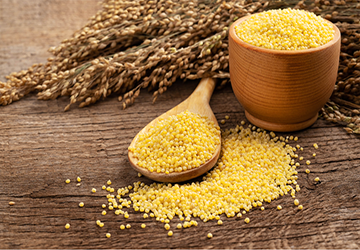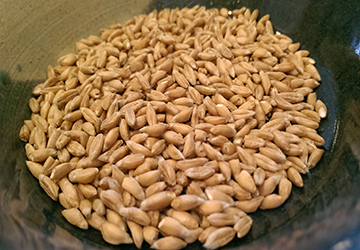Throughout history, grains have been a cornerstone of the human diet, providing essential nutrients and energy. With the advent of modern farming, many ancient grains were sidelined in favor of more profitable crops. However, as people become more health-conscious, these forgotten grains are making a significant comeback.
The following are the top 5 ancient grains that have reemerged as superfoods in contemporary cuisine. Incorporating them into your diet introduces unique flavors and textures and brings numerous health benefits to ancient grains.
Millet: A Versatile Staple
Cooking with millet is like rediscovering an old friend. Originating from Africa and northern Asia, millet has been a vital source of nutrition for thousands of years. It's gluten-free and packed with magnesium, phosphorus, and fiber.
Ancient grain recipes incorporating millet range from porridges to salads and desserts. Millet can be cooked fluffy for salads or creamy for a comforting porridge. With its mild flavor, it seamlessly integrates into a variety of dishes.

Quinoa: The Andean Powerhouse
Quinoa, native to the Andes Mountains, is more than a superfood. It was the gold of the ancient Inca Empire. A complete protein, quinoa contains all nine essential amino acids. Additionally, it is rich in magnesium, iron, and dietary fiber.
Cooking with quinoa is straightforward. It can replace rice in most dishes, be added to salads, or be used as a base for a protein-packed breakfast bowl. Its nutty taste and unique texture have made quinoa a favorite in ancient grain recipes.
Teff: The Ethiopian Marvel
This tiny grain, predominant in Ethiopia, has been a staple for millennia. Teff flour is the primary ingredient in injera, a sourdough flatbread integral to Ethiopian cuisine. It's an excellent source of calcium, iron, and protein.
When considering the benefits of ancient grains, Teff stands out, especially for those with gluten sensitivity, as it's gluten-free. Experimenting with Teff in various dishes can open up a world of culinary delights.
Farro: The Mediterranean Gem
Hailing from the Fertile Crescent, Farro is an ancient form of wheat. It's known for its nutty flavor and chewy texture. Farro's resurgence in the culinary scene is well-deserved and rich in fiber, magnesium, and vitamins.
Cooking with millet, quinoa, or other grains like farro offers numerous possibilities. Farro can be added to soups and salads or used as a substitute for arborio rice in risottos. As with most grains, it soaks up the flavors it's cooked with, making it highly versatile.
Amaranth: The Aztec Treasure
Amaranth was a significant food source for the Aztecs, and its cultivation dates back to 4000 B.C. This grain is a protein, lysine, and essential amino acids powerhouse. Moreover, its abundant fiber content promotes digestive health.
Pop amaranth grains like popcorn, cook them as porridge or integrate them into your favorite ancient grain recipes. Its versatility and the multitude of benefits of ancient grains it offers make it indispensable in a modern kitchen.
Why Ancient Grains Deserve the Spotlight Again
The popularity of ancient grains isn't merely a trend—it's a reawakening of age-old nutritional wisdom. These grains have withstood the test of time, not just because of their adaptability to various terrains but also because of their myriad health benefits.
● Rich in Nutrients: Many grains are brimming with essential vitamins and minerals. For instance, quinoa is an excellent magnesium, potassium, and iron source. Such nutrients play a vital role in metabolic processes and overall health.
● Diverse in Flavor: Ancient grains introduce various flavors to our palate. While millet is mild and slightly nutty, amaranth has an earthy undertone. This range of tastes can rejuvenate and diversify everyday meals.
● Support for Digestive Health: The fiber content in these grains is commendable. Regular consumption can aid digestion and foster a healthy gut environment. Considering the rise in digestive disorders today, these grains can offer a natural remedy.

Re-introducing Ancient Grains into Modern Cooking
One of the genuine joys of exploring ancient grain recipes is the opportunity to revitalize traditional dishes. With the health benefits of ancient grains in mind, many chefs and home cooks are reimagining age-old recipes for the modern table.
● Breakfast Boost: Swap your regular cereal with a mixture of popped amaranth, cooked quinoa, or millet. You'll find it satiating and energizing, setting a positive tone for the day.
● Revolutionizing Salads: Cooking with millet, quinoa, etc., can give a delightful twist to salads. The grains contrast texture, and their ability to soak up dressings and sauces only amplifies the flavor profile.
● Wholesome Soups and Stews: Grains like farro or barley are excellent additions to soups and stews. They add a heartiness to the dish and are incredibly comforting during colder seasons.
Ancient Grains and Sustainability
Another reason to laud ancient grains is their environmental footprint. Many of these grains, such as millet and Teff, are drought-resistant. In times of erratic weather patterns and climate change, cultivating such grains becomes not just a dietary choice but a sustainable one.
● Lower Water Requirements: Grains like millet require considerably less water than many contemporary crops, making them a sensible choice in drought-prone areas.
● Soil Health: Grains like quinoa and amaranth improve soil health by enhancing nutrient content. As a result, they play a crucial role in sustainable agricultural practices.
Incorporating Ancient Grains in Daily Life
Embracing ancient grains doesn't require a radical shift in diet but a simple incorporation. Here are some simple ways to start:
● Baking with Ancient Grains: Explore using teff or amaranth flour for your baking needs. Not only do they add a unique flavor, but they also enhance the nutritional profile of baked goods.
● Snack Time: Popped amaranth or millet-based bars can be excellent mid-day snacks. They're fulfilling and pack a punch of energy.
Conclusion
The rich tapestry of our global culinary heritage is interwoven with ancient grains. They have sustained civilizations and nourished people, and now, they're returning to our plates, bringing myriad flavors, textures, and health benefits. The options are endless, from cooking with millet to preparing dishes with quinoa and Teff.
The increasing popularity of these grains is a testament to their enduring appeal and the undeniable benefits of ancient grains. Embracing them means a healthier lifestyle and a journey through the annals of culinary history. So, the next time you're considering what to cook, dive deep into ancient grain recipes and relish the taste of tradition.
-
How to Deal with Common Pet Behavioral Issues
Pets bring immeasurable joy and companionship into our lives, but let's face it—they can also come with their fair share of behavioral challenges. Every pet owner has encountered a quirky behavior or two, from incessant barking to furniture-chewing escapades. Fear not; we're here with some down-to-earth tips on tackling these common pet behavioral issues.
-
How to Brew the Perfect Cup of Artisanal Coffee?
The art of brewing coffee has evolved considerably over the years, moving from instant coffee mixes to intricate brewing processes that extract coffee beans' true essence and flavors. The rise of artisanal coffee methods highlights the brewing process's significance in determining the final cup's quality and taste. If you're a coffee enthusiast eager to master brewing the perfect cup of artisanal coffee, this article is just for you. We will delve into the core elements:
-
5 Drinks You Must Consume in Summer for Glowing Skin
Summer's here! Escorting heat, glaring sun or perspiration. Yeah, it’s summer time for your skin to lust for a supplement. Gosh, who’s interested in the bored skin that lacks any brightness? But don't worry! When it's summer and there is a high heat, you can still make your skin healthy. It all starts with one simple thing: dehydration!